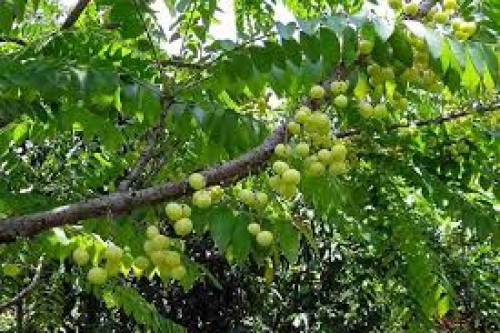off
-
Sold
-

out
Amla Plant: Uses, Care & Advantages
The Amla Plant (Phyllanthus emblica), also known as Indian Gooseberry, is a highly revered medicinal plant in Ayurvedic tradition. Known for its small, greenish-yellow fruit rich in Vitamin C and antioxidants, amla is used in health, beauty, and cuisine. It is a hardy and beneficial tree that grows well in tropical and subtropical climates.
Care of the Amla Plant
Amla is a low-maintenance, drought-resistant tree that can live and yield fruit for decades with minimal effort. Here’s how to care for it:
- Climate: Grows best in tropical to subtropical regions. It can tolerate high temperatures and moderate frost.
- Sunlight: Requires full sun exposure—minimum 6 to 8 hours daily.
- Soil: Prefers well-drained loamy or sandy soil. Tolerates mildly acidic to alkaline pH (6.5–8.5).
- Watering: Needs moderate watering. Water young plants regularly; mature trees need watering only during dry spells.
- Fertilization: Use organic compost and manure once or twice a year. A balanced fertilizer (NPK 10-10-10) in early growth stages supports healthy development.
- Pruning: Prune lightly to remove dead or diseased branches and promote healthy canopy formation.
- Pests & Diseases: Generally pest-resistant, but aphids or borers may appear. Neem oil or natural insecticides are effective.
Advantages of the Amla Plant
- Rich in Nutrients: Amla is a superfood rich in Vitamin C, antioxidants, iron, calcium, and fiber.
- Strengthens Immunity: Boosts immune system and helps fight infections naturally.
- Supports Digestion: Improves gut health, metabolism, and detoxifies the liver.
- Promotes Hair & Skin Health: Used widely in hair oils and skincare for its nourishing and anti-aging properties.
- Long-Lived & Sustainable: Amla trees are long-living, require little care, and contribute to environmental balance.
- Drought Resistant: Mature plants are highly tolerant of dry conditions and need little water.
Uses of Amla
- Medicinal: Widely used in Ayurveda to treat respiratory problems, high cholesterol, diabetes, and more.
- Culinary: Consumed raw, pickled, or cooked in chutneys, candies, juices, and herbal supplements.
- Cosmetic: Amla oil and powder are used in shampoos, hair masks, and face packs for glowing skin and strong hair.
- Nutraceutical: Amla supplements and extracts are popular in the health and wellness industry.
- Environmental: Acts as a good shade tree and is used in agroforestry systems for land restoration.
Conclusion
The Amla plant is a powerhouse of health benefits and a symbol of longevity and resilience. Whether used for its therapeutic properties, nutritional value, or beauty applications, amla is a valuable addition to any garden or farm. With minimal maintenance and high returns, it offers an ideal blend of traditional wisdom and modern health solutions.